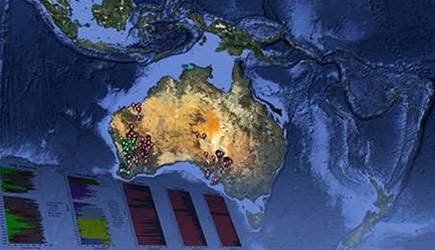AuScope looks to standardise geospatial data
- Published
Geospatial organisation AuScope has launched an information portal and software stack to facilitate data sharing between Government agencies, researchers, and the mining industry.
 SISS offers open access to national geological data. Credit: Aiden Sehovic, AuScope.
SISS offers open access to national geological data. Credit: Aiden Sehovic, AuScope. Developed in collaboration with the CSIRO, the Spatial Information Services Stack (SISS) provided organisations with a guide to what developers believed to be the minimum number of services required for an effective national data infrastructure.
It involved various open standards, including Web Feature Service, GeoServer, FullMoon and HollowWorld.
According to CSIRO software engineer Robert Woodcock, the partners hoped to spark user demand for open standards and consequently prompt movement from software giants such as Oracle and Esri.
“We’re small fish in the software development game, but there is no reason why a company like Esri would want to develop open standards on their own,” he told iTnewstoday.
“The idea behind this infrastructure is that no man is an island ... We’re really forming a bit of a cultural change here, asking people to cooperate across organisational boundaries.
“If we make more readily available, then we improve the prospectivity of Australia,” he said.
The AuScope portal currently provides access to ‘terabytes’ of rich data, including geologic units and mining information from various States, geophysics data from Geoscience Australia, and AuScope’s National Virtual Core Library.
Data was hosted by the responsible agencies and registered in AuScope’s central repository, which also could be accessed by standard Geospatial Information System (GIS) software packages.
Without a common query and results interface, Woodcock said CSIRO researchers had previously spent four months simply collecting and formatting geochemistry information from various sources.
Many researchers and companies ended up relying on using maps produced by Geoscience Australia that featured year-old data by the time they were made available, he said.
Woodcock said AuScope and the CSIRO had initially encountered some resistance from data sources, as organisations grappled with new firewall handling, policy, and data licensing requirements.
The SISS launch represented three years of work and $1 million in funding from the National E-Research Architecture Taskforce.
According to AuScope CEO Bob Haydon, SISS data would allow “anyone” to investigate Australia’s geological history for research into climate change, sustainable energy, water, mineral resources and geological activity such as earthquakes.
“This is clearly just the first step but it is very timely as some of the really big challenges that we face nationally and globally require multi-organisational, as well as multidisciplinary approaches,” he stated today.
“Quality integrated data products will provide national impact by attracting mineral explorers to Australia and helping drive successful exploration outcomes.”